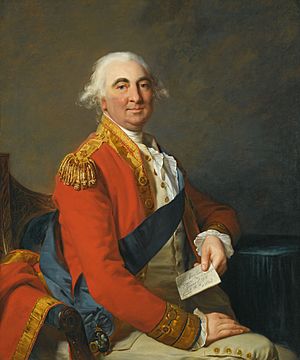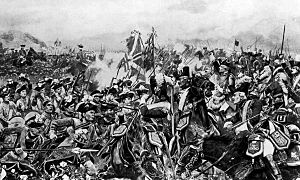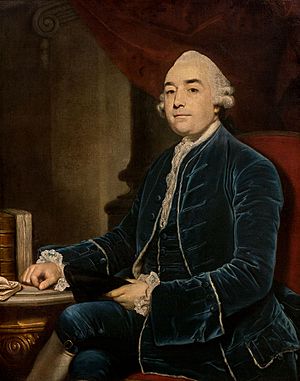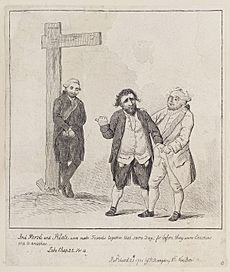William Petty, 2nd Earl of Shelburne facts for kids
Quick facts for kids
The Most Honourable
The Marquess of Lansdowne
KG PC
|
|
|---|---|

Portrait by Jean-Laurent Mosnier, 1791
|
|
| Prime Minister of Great Britain | |
| In office 4 July 1782 – 26 March 1783 |
|
| Monarch | George III |
| Preceded by | The Marquess of Rockingham |
| Succeeded by | The Duke of Portland |
| Leader of the House of Lords | |
| In office 4 July 1782 – 2 April 1783 |
|
| Prime Minister | Himself |
| Preceded by | The Marquess of Rockingham |
| Succeeded by | The Duke of Portland |
| Home Secretary | |
| In office 27 March 1782 – 10 July 1782 |
|
| Prime Minister | The Marquess of Rockingham Himself |
| Preceded by | The Earl of Hillsborough (Southern Secretary) |
| Succeeded by | Thomas Townshend |
| Secretary of State for the Southern Department | |
| In office 30 July 1766 – 20 October 1768 |
|
| Prime Minister | The Earl of Chatham The Duke of Grafton |
| Preceded by | The Duke of Richmond |
| Succeeded by | The Viscount Weymouth |
| Personal details | |
| Born | 1737-05-02 Dublin, Ireland |
| Died | 1805-05-07 Westminster, England |
| Resting place | All Saints Churchyard, High Wycombe, England |
| Political party | Whig |
| Spouses | Sophia Carteret (married 1765, died 1771) Louisa FitzPatrick (married 1779, died 1789) |
| Children | 3 |
| Parents | John Petty, 1st Earl of Shelburne Mary Fitzmaurice |
| Alma mater | Christ Church, Oxford |
| Signature | |
| Military career | |
| Allegiance | Great Britain |
| Service/ |
British Army |
| Rank | General |
| Battles/wars | Seven Years' War |
William Petty Fitzmaurice, 1st Marquess of Lansdowne (born May 2, 1737 – died May 7, 1805), was an important British politician. He was also known as the Earl of Shelburne for most of his life. He served as the first Home Secretary in 1782. Later, he became Prime Minister from 1782 to 1783. This was during the last part of the American Revolutionary War. His biggest achievement was making peace with America.
Lord Shelburne was born in Dublin, Ireland. He spent his early years there. After studying at Oxford University, he joined the British Army. He fought in the Seven Years' War. For his bravery, he became an aide-de-camp to King George III. He then entered politics, becoming a member of parliament in 1760. When his father died in 1761, he inherited his title and joined the House of Lords.
In 1766, Shelburne became the Southern Secretary for two years. He left this role and joined the group that opposed the government. After the government changed, Shelburne became Prime Minister in 1782. This happened after the previous Prime Minister, Lord Rockingham, died. The American War was still going on when he took office.
He lost his position in 1783 when he was 45. Shelburne felt his career was a failure, even though he held many high offices. He was a skilled debater. He believed his problem was that he always connected with "clever but unpopular" people.
Contents
Early Life and Education
William Fitzmaurice was born in Dublin. He was the first son of John Fitzmaurice. His family later changed their last name to "Petty." William grew up in the "remotest parts of the south of Ireland."
When he started at Christ Church, Oxford, in 1755, he felt he had "everything to learn." He said his tutor helped him with his studies. But he learned most about manners and the world from the "clever but unpopular" people he met.
Military Career and Entering Parliament

After university, William joined the army. He served in the 20th Foot regiment during the Seven Years' War. He became friends with Charles Grey, another officer. In 1757, he took part in a naval attack on Rochefort. The next year, he fought in Germany. He showed great bravery at the Battle of Minden and Battle of Kloster Kampen.
Because of his service, he was made an aide-de-camp to King George III. He also became a colonel. This promotion caused some arguments because he was promoted over more senior officers. Even though he didn't fight actively after this, he continued to be promoted. He became a major-general in 1765, a lieutenant-general in 1772, and a general in 1783.
In 1760, while still abroad, Fitzmaurice was elected to the British House of Commons. He was re-elected in 1761. He was also elected to the Irish House of Commons. However, in May 1761, his father died. William became the second Earl of Shelburne. This meant he moved from the House of Commons to the House of Lords.
Ideas on Economics and Trade
Shelburne was very interested in how countries manage their money and trade. He believed in free trade. This means countries should trade with each other without many rules or taxes. He talked to many experts from England, Scotland, France, and America. He was friends with Benjamin Franklin and David Hume.
He met with French thinkers in Paris. By the 1770s, Shelburne was the most important British politician who supported free trade. He said he learned about free trade from long talks with Adam Smith in 1761. Shelburne believed that free trade would help Britain grow richer.
Early Political Career
Shelburne's army role brought him close to Lord Bute. Bute was the King's main advisor. In 1761, Bute asked Shelburne to get support from Henry Fox. Fox was a powerful politician. Shelburne was against another politician named Pitt. So, Shelburne asked his supporter, Barré, to speak strongly against Pitt in parliament.
In 1762, Britain was trying to make peace after the Seven Years' War. A peace deal was made, but many people thought it was too easy on France and Spain. Shelburne defended the deal in the House of Lords. He said the war started to protect British colonies in North America. He believed the peace deal helped keep them safe. Soon after, Bute resigned as Prime Minister. George Grenville took his place.
Shelburne joined Grenville's government in 1763 as First Lord of Trade. By this time, Shelburne had started to admire Pitt. He tried to get Pitt into the government, but it didn't work. So, Shelburne resigned after only a few months. He also upset the King by supporting John Wilkes. Shelburne then went to live on his estate for a while.
Southern Secretary Role
When Pitt returned to power in 1766, Shelburne became Southern Secretary. This job involved dealing with foreign affairs. However, when Pitt was ill, Shelburne's ideas for a peaceful approach to America were stopped by other politicians and the King. In 1768, he was removed from his job. During the Corsican Crisis, when France invaded Corsica, Shelburne wanted to help the Corsicans. Some secret help was given, but Britain decided not to start a war with France.
In 1768, a town in Massachusetts, USA, was named Shelburne, Massachusetts in his honor. Shelburne sent a church bell to the town, but it never arrived.
Joining the Opposition
Shelburne then joined the group that opposed the government. He continued to work with William Pitt, 1st Earl of Chatham. They both criticized the government's policies before the American Revolutionary War started in 1775. As the war went on, Shelburne worked with other politicians to challenge the government. After a British army surrendered in 1777, Shelburne called for all British troops to leave America.
Becoming Prime Minister

In March 1782, the government changed. Shelburne agreed to join the new government under Lord Rockingham. He made sure the King would agree to recognize the United States. Lord Rockingham died suddenly in July 1782. Shelburne then became Prime Minister.
Shelburne's appointment made Charles James Fox and his supporters, including Edmund Burke, resign. Burke compared Shelburne badly to Rockingham. One of the new people Shelburne brought into his government was 23-year-old William Pitt the Younger. Pitt, the son of Shelburne's old friend, became the Chancellor of the Exchequer (in charge of the country's money). That year, Shelburne was also made a Knight of the Order of the Garter.
Working for Peace
Shelburne's government continued to talk about peace in Paris. Richard Oswald was the main negotiator. Shelburne invited a French peace envoy to his home in England. They quietly agreed on many points that would form the basis for peace. Shelburne's own representatives also talked separately with American leaders. This led to an agreement on American independence and the borders of the new United States.
Shelburne agreed to generous borders for the United States. He gave them a large area of land west of the Appalachian Mountains. However, he refused Benjamin Franklin's request for Canada. Historians often say the treaty was very generous to the United States. This was because Shelburne believed in strong economic ties between Britain and the new United States. He thought that giving America more land would help its population grow. This would create more markets for British goods. As the French foreign minister said, "The English buy peace rather than make it."
Why He Lost Power
When Fox left the government, he joined forces with Lord North. This new group became very powerful in the opposition. In April 1783, this group forced Shelburne to resign. The biggest success of Shelburne's time as Prime Minister was agreeing to the peace terms. These terms led to the Peace of Paris, which ended the American War of Independence.
His plans to change the public service might have also led to his downfall. He also wanted to create a law to promote free trade between Britain and the United States.
Later Life
When Pitt became Prime Minister in 1784, Shelburne did not get a place in the government. Instead, he was given the new title of Marquess of Lansdowne. From this time on, he stopped taking an active part in politics. He generally supported Pitt's policies. In 1803, he was made an Honorary Member of the American Academy of Arts and Sciences.
Family Life
Lord Lansdowne was married twice.
His first wife was Lady Sophia Carteret (born August 26, 1745 – died January 5, 1771). She was the daughter of John Carteret, 2nd Earl Granville. Through her, he gained the Lansdowne estates near Bath. They had at least one child:
- John Henry Petty, 2nd Marquess of Lansdowne (born December 6, 1765 – died November 15, 1809). He was a Member of Parliament. After seeing the French Revolution, he became a critic of the war with France. He also spoke against stopping democratic movements at home. He died without children at age 43.
His second wife was Lady Louisa FitzPatrick (born 1755 – died August 7, 1789). She was the daughter of the 1st Earl of Upper Ossory. They had at least two children:
- Henry Petty-Fitzmaurice, 3rd Marquess of Lansdowne (1780–1863). He inherited his half-brother's title.
- Lady Louisa Fitzmaurice (born before 1789).
Lord Lansdowne's brother, The Hon. Thomas Fitzmaurice (1742–1793), was also a Member of Parliament.
Images for kids
-
Dedication to Shelburne in volume I of Joseph Priestly's Experiments and Observations on Different Kinds of Air (1774)
See also
 In Spanish: William Petty Landsdowne para niños
In Spanish: William Petty Landsdowne para niños
- Lansdowne portrait



